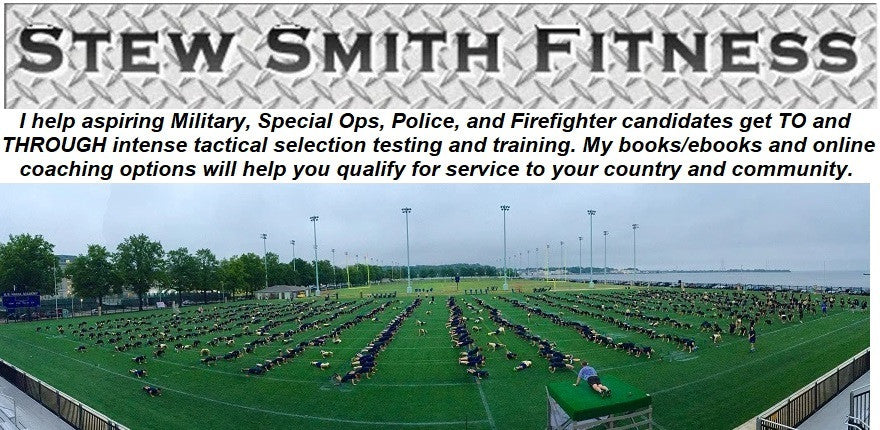This article on the knee is the third of three segments on the most injured body parts in military / athletic training. Check out the Stew Smith Archives for previous articles specifically discussing injury prevention and rehab of the lower back and shoulder. Like the shoulder and the lower back, the knee joint is susceptible to injuries of the connecting tissues of ligaments and tendons, compression tissue of the cartilage, and muscular strength and flexibility imbalances. Often running can cause these issues especially if the runner is overweight, wearing improper footwear, or using poor technique.
The most common of knee injuries is Patello-Femoral Pain Syndrome (PFPS) or commonly called “runner’s knee.”(link http://www.drpribut.com/sports/spknees.html) and Iliotibial Band (ITB) (link http://www.drpribut.com/sports/spitb.html) For most people these injuries are classified in the “over-use injury” category. In fact, the nick name for ITB at SEAL training is “I Tried BUDS” due to so many students failing out of training with this over-use injury. PFPS can occur in avid runners as well as people who decide to go running for the first time in several months or even years without proper training prior to running again. It is also important to rule out other knee problems when knee pain occurs and not assume every pain as "runner's knee" for you could be suffering from a knee injury that requires surgery. Usually, if your knee injury involves ligaments or cartilage, surgery is required and can be relatively quick with a speedy recovery thanks to the latest in arthroscopic surgery techniques.
To help prevent injuries such as runner’s knee, ITB, and other injuries (not including sudden impact damage) there are a few rules of thumb to go by:
1) Do not run too much, too soon – start a running program gradually even if you were on the cross-country team ten years ago.
2) Replace old shoes every 300-400 miles of at least every 6 months and try not to use your running shoes as your everyday shoes. We walk differently than we run.
3) Stretch daily and become flexible especially in the hamstrings, calves, and lower back.
4) Strengthen thigh and hamstring muscles so you do not create imbalances in strength and flexibility.
5) Always rest, ice and only do non-impact aerobics such as swimming, biking or rowing if your knees hurt when you run.
6) My rule: If it hurts to walk – DON’T RUN! If it hurts to run – just walk.
Here are some pictures and descriptions of some of the few stretches and exercises that are part of any of my books and eBooks. Also, visit www.drpribut.com for more information on injuries of the knee and other running related issues.
Hamstring / Lower back Stretch - From the standing or sitting position bend over and touch your toes
Thigh Stretch Standing – Pull heel to rear. If you cannot do this stretch as shown, just bend your knee in the same fashion – that will stretch your thigh muscles.
Calf Stretch – Lean against a wall and push your heel to the floor with most of your weight on your back leg.
Hip / outer thigh stretch – ITB Stretch – Sit and cross your legs. Pull your knee to your chest and hold for ten seconds – Switch and repeat with other leg.
The stretches above and the minimum recommended stretches you should do for at least 30 seconds each after a brisk5:00 warm up jog. Always stretch after you have warmed up the muscles and gotten the blood flowing to the muscles and connective tissues being used.
The exercises below will also help strengthen your knee joint through exercise of the connecting muscle groups.
Straight Leg Lifts strengthens the quadriceps. Lie on the floor. Lift one leg about 6-12 inches off the floor and hold for 10 seconds flexing the thigh muscles. Lower and repeat 10 times. Switch legs, repeat 5 times and work up to 10 sets of 10 repetitions. You can do this anywhere – even while watching TV.
The 1/2 squat - While standing, hold the pose and push yourself up and down within a 8-12” range of motion....just like riding a horse. Do about 5 sets of 10-20 in a workout.
These are just some of the exercises and stretches you can use to prevent injuries. If you have any questions email Stew Smith at stew@stewsmith.com. Also feel free to visit the StewSmith.com Fitness eBooks Store where we are Preparing People for the Jobs they Dream of...
If you would like to pay online for any of the downloadable workouts that have worked for several clients of the StewSmith.com PT Club please click the Yahoo Store link: Stew Smith PT Club
OR
Check out the Stew Smith Fitness Catalog
